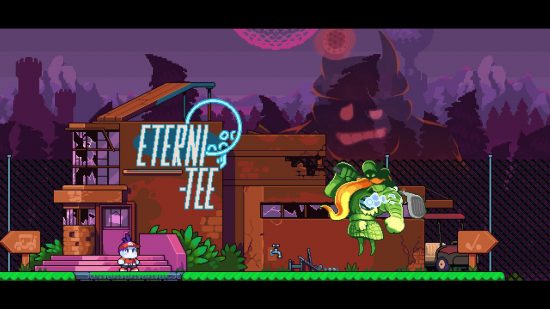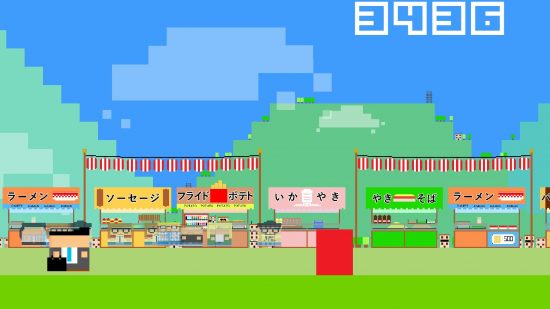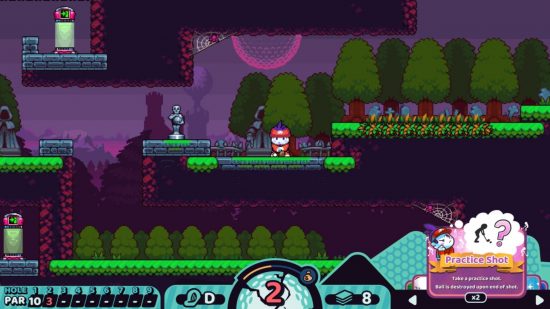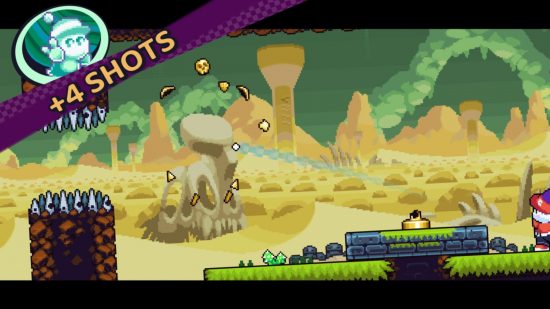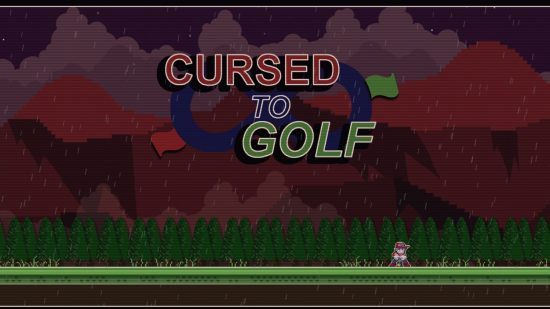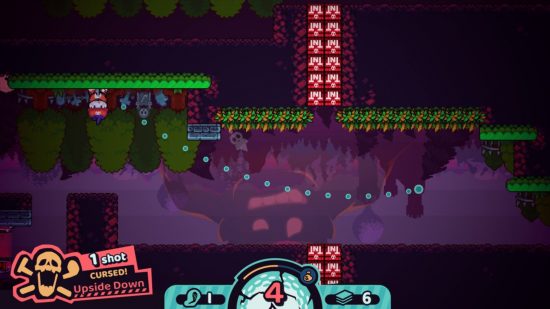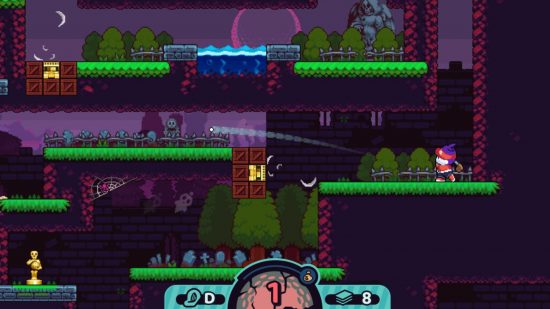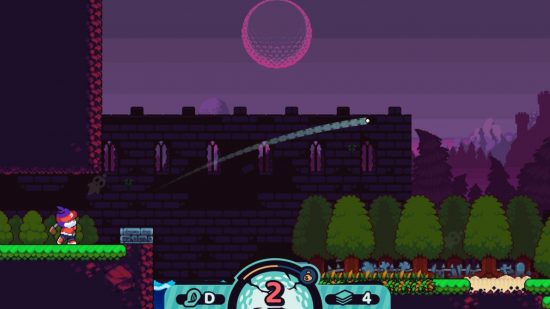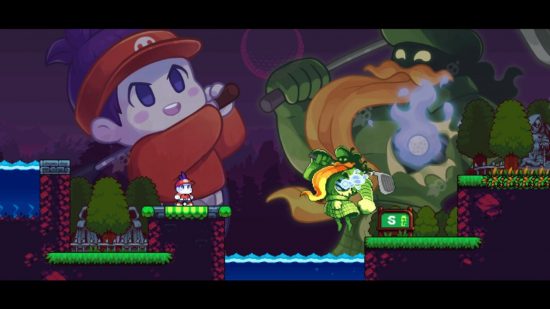Cursed to Golf came as a big surprise when I first saw it. The game’s director Liam Edwards presented an amusing video about it, alongside repeated uses of the phrase ‘golflike’. It’s great.
The first thing I thought wasn’t anything about the game, however. I was like, “I know that voice! Who is that?” Turns out I’ve listened to dozens of hours of Liam talking on his podcast Final Games. I’ve heard him chat to some of my favourite developers, like Lucas Pope, Bennet Foddy, and Derek Yu. I’d also heard him mention that he wanted to make his own game in the future.
Now, back to the time of the announcement, my tiny brain was blown. Some dude in my past self’s ears was now doing the thing he wanted to do, and what’s more, the game looked hot. Gorgeous pixel art and earwormy music made a good first impression, but the best bit for me was the concept, which seemed to be, “what if golf… but Castlevania?” That was before I’d even played it of course, and there is, in fact, a lot more to it than just that.
Then, I gave it a go at the WASD event in London and got the chance to have a little chat with Liam. The main thing that stuck in the back of my brain was hearing that the game started out as an itch.io demo. Anything else he said may as well have just been gibberish, because I’d just had a big awful idea: what if I wrote an article called ‘from itch to Switch’? That silly name was all I needed. Now I had to write it. But it would’ve helped if I remembered everything else he said.
So, I arranged a call with Liam, who’s living in Japan and working on the game at Chuhai Labs. What was breakfast for me was dinner for him. So, to start, I ask how it’s going. “Never ends, never ends. It’s always something, whether it’s like a PS4 patch that needs to go, or there was a bug that you thought you fixed […] or there’s an event next week and you’ve got to create a special demo build, or we’re trying to find out about the Steam Deck review process, like…it’s always something.” Crikey, I hope he’s okay.
The main struggle is the fact that the game is coming to every platform. “I never want to do it ever again, never ever ever, it’s the most stressful experience I’ve ever had in my life, just trying to ship on every platform… it’s happening, but it was looking unlikely, it was looking like we were going to have to delay because we were just stuck in PlayStation submission hell […] it was like a dance, a tango for a month with PlayStation […] it was an absolute nightmare.”
But, it sure is a nice nightmare to have, I assume. Having the problem of shipping on every platform with support from a publisher (Thunderful) and trailers in places like a Nintendo Direct may result in stress, but it’s a far cry from noodling around and doing game-making tutorials just to create little prototypes. That’s exactly what Liam was doing after leaving Rockstar Games (where he worked on Grand Theft Auto V and Red Dead Redemption II, among others).
He moved to Japan, started teaching English, worked on the Final Games podcast, and learned more about making games. “Everyone works in these huge teams [at Rockstar], this small cog in this big machine. And then I met loads of indie creators and loads of developers that work in smaller teams, and their worlds were so contrasting to mine. They actually had creative input.”
“I got introduced to more and more people here who made games by themselves […] We have BitSummit over here in Japan, which is this huge celebration of indie games. Then it just became very clear to me that, like, there’s another side to the games industry.” This inspired Liam to start making his own prototypes, using his prior knowledge alongside these game-making tutorials.
“I made a game that was like an endless runner, ‘cause it was an easy thing to do. It was super inspired by Japan. It was called Salaryman Suzuki-san – it was this really bad kind of almost Flash game-style thing. But it was the first thing I made entirely by myself. And people enjoyed, you know, fucking around with it, or whatever.” This game led to one situation with Ojiro Fumoto, maker of Downwell and Poinpy.
“I remember going to a Tokyo indies thing with Salary Suzuki-san at the time. And he had to translate for me because my Japanese wasn’t very good. So, I was sitting with the developer of Downwell with my shitty Flash game. And he’s talking. He’s, you know, translating for me, about this game? I thought […] ‘I can’t believe I get to do this kind of thing.’”
Building this community of other developers seemed key for Liam, moving from a cog in Rockstar to an English teacher and podcaster with a hobby on the side, and then onto getting job offers. He got one from Q Games, makers of the PixelJunk series. Dylan Cuthbert, a programmer on Starfox, leads the studio.
“They’re a big studio in Kyoto, and they’ve got 50 people […] I was kind of hesitant having been a Rockstar […] but [Dylan] sort of reassured me. He’s like, ‘no, you’re gonna come on as a game planner, you’re going to help co-lead this team’ […] so I joined Q and that’s where everything sort of snowballed into being where I am now.”

From there, Liam gained even more experience, became the co-director of an Apple Arcade title called Scrappers, and then launched it just as the Covid-19 pandemic hit. “We worked together this entire time […] and then had to ship our game in the most muted, negative way […] that kind of sucks.” There was a silver lining, however, as Liam suddenly had a lot more time on his hands.
“So I just started prototyping again. And when I was prototyping, I was experimenting with literally anything, but I was listening to a podcast – it’s all full circle for me, podcasts and videogames. I was listening to a podcast called Eggplant, which […] used to be a Spelunky-focused podcast. Now it’s all about roguelikes, and it’s co-hosted by some super, super intelligent people.
“I’m not very good at roguelikes. But you know, they’re kind of interesting. And I never thought about making one. But then I’m kind of wondering why nobody had ever made a physics roguelike. I don’t know, Yoku’s Island Express was probably the only thing I could think of…
“Well, I started just making a Metroid-like dungeon. But with a ball that bounced around, and you would hit enemies and try to make it avoid hazards and to get to the end of the dungeon without losing all of your life. And as I was doing it, I was like, ‘this is like golf.’”
This realisation was especially useful for Liam, who has lots of experience with golf. As a kid, when he just wanted “to stay home and play Zelda” he spent a lot of time playing golf due to his parents’ encouragement. Sure, he’s not winning The Masters any time soon, but this experience came in handy perfectly when prototyping.
“It became this thing that my knowledge of golf could be converted, [so] the health is your par, and that’s how many shots you’ve got to the end of the dungeon, which should be the hole. And then, you know, you’re flinging this ball around… it’s kind of like a golf swing – you have to time the power, the angle. And then yeah, it just spiralled into this game called Cursed to Golf, which I didn’t think very much of…”
Luckily for us, while Liam didn’t think too much of it, this community he’d become a part of since moving to Japan was a little more excited. With Discord events replacing real-life ones during covid, he got invited to one by Bannon Rudis (director of River City Girls by WayForward), who’d seen the prototype on Twitter. Tentative at first due to its unfinished nature, Liam decided to take the opportunity.
“Because we were working from home at the time, I kind of exploited that and maybe spent a lot more time not doing my job. And I was like, ‘I’m gonna finish a nine-hole demo of this and see what I can do.’ So I spent two weeks in self-imposed crunch, where basically every day I was making levels, making power-ups, and trying to get a finished demo. So then the event happens, and people are like ‘this is really cool.’”
That response was echoed by a lot of people. One of them was Jirard Khalil, also known as The Completionist, who encouraged Liam to release it. “I hadn’t really thought about releasing the demo. I just thought about sharing it, because it’s good. And then I thought, ‘well, soon enough I’m gonna be moving on to the next project, [so] I might as well just get it done.’” You can see the demo’s title screen below.
“For me, it was a case of… I just want things out of my life. So I can move on to the next thing, experiment, the next idea. So I was like, ‘okay, I’ll put it on itch.io’ where all the other buckets of game prototypes are and posted it […] And yeah, then a lot of people played it.” With the help of Twitter and Discord, more people played the prototype. More people playing the prototype led to more people writing about the prototype. And more people writing about the prototype led to publishers reaching out.
While there was interest from various people, Thunderful’s Ed Valiente, an ex-Nintendo of Europe employee, reached out. “He said, ‘it’s a bit rough […] but if we give you a team and everything, this could be a really amazing thing.’” Best of all, he said that Cursed to Golf feels like a Nintendo game, “magic words” to Liam (and I assume about a million other devs).
But how the heck would Liam get a team together? “Now, the problem is that I live in Japan. It would mean I have to start a company, do all these things to be able to accept funding, and a whole bunch of bureaucratic nonsense that is very, very hard to do. So [it’s] kind of impossible for me to take on that test by myself.”
Luckily, this is where community connections once again helped push Cursed to Golf over the next hurdle. Mark Lentz, chief of communications at Chuhai Labs and one of Liam’s “closest colleagues and greatest friends”, used to work with him at Q Games. Mark offered to help get the team together, sort out the contract stuff with Thunderful, and help get the game made. So that’s what happened.
Well, no. It didn’t just happen. The journey it’s been on since development actually properly started is the story of any videogame’s development. While Liam made clear they all worked hard but not to an unhealthy extent, their time making it is still full of anecdotes and accidents that led to crucial elements that make the game what it is now.
One key aspect of the game is the spin mechanic. I remember sitting down at WASD, playing the game, thinking it was cool, and having a good time. Then Liam comes over, almost exasperatedly excited, and explains the spin mechanic to me. I skipped the tutorial because I’m overconfident, so just had no idea it was there.
After Liam sat down with me and we chatted more, he explained the mechanic in a little more detail, how you can set yourself challenges or pull off trick shots. I try one, over-hitting the ball on purpose to try and backspin it into the hole. It lands, bounces once, twice, and then plonks into the hole. We both let out a mini cheer that was basically a wordless ‘heck yeah’.
That’s pretty cool, but it almost wasn’t part of the game at all. “It’s funny, having been behind the other side of the curtain now, it just makes me laugh how games get made and how things that I think players obsess about end up just being a little decision […] because I know they just come out of nowhere.”
It’s a bit blurry where Liam’s little decision came from, but it seems like it was triggered by playing an old PGA Tour game. “I just came in one day, and I was like, ‘we should add spin.’ We didn’t have spin at all. And it was really hard because the ball would just bounce off platforms. And [because of this] we experimented, stupidly, with things like […] invisible bumpers that would try to roll the ball out automatically. And that looked really weird because it looked like it was moving by itself.”
He came in and asked Sean Fisher, lead programmer on the game, if they could add spin. “Within five minutes, we had a test version. And I was like, ‘holy fuck, this changes everything.’ This revelation came early enough to change levels around and allow for more experimentation. It also led to new revelations.
“Literally just yesterday [n.b. we chatted about three weeks ago], I figured out that I could do wall jumps. I could hit the ball into the wall, apply all the spins and bounces upwards and then do the same on the other wall and then basically climb up the wall. Not infinitely because it degrades. But if the tunnel is small enough, you’d go back up the way you came.”
This is the “secret sauce”, as Liam puts it. With the addition of the spin mechanic, the difficulty curve becomes more flexible—there’s no one definite right answer. “[I can go from just] hitting the ball, to hitting the ball with spin. Now I hit the ball and spin to do platforming. Now I hit the ball and spin to do wall jumps.” This crucial aspect came out of the blue, and is “something that completely defined the entire experience.” I know that’s a quote, but I sure do loudly agree.
So, after everything he’s been through, what’s Liam proudest of? “I’m proud that you can always point a finger at an individual for every aspect of the game, whether it’s the art, Jon Davies, the music, Mark Sparling, the programming, Sean Fisher. You can almost point a finger at every person and be like, ‘you’re responsible for that.’ And then they can take the credit for that.”
And what’s next after Cursed to Golf? Well, Liam doesn’t want to lose that free creativity that helped shape the original prototype. “Yeah, I think the idea is to maybe hide myself away for a month in some remote part of Japan, to just take a break and also be like, ‘what other genres can I fuck up?’ I broke roguelikes and golf, now what do I do… like… walking sims and cricket?” I’d play it.


